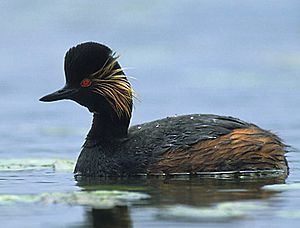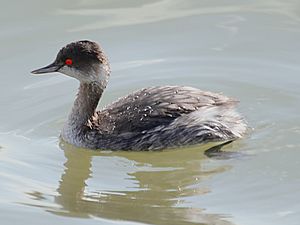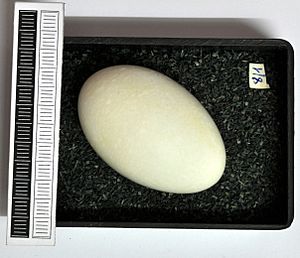Black-necked grebe facts for kids
The black-necked grebe (Podiceps nigricollis) is a type of water bird. In North America, people call it the eared grebe. It belongs to the grebe family. You can find these birds on every continent except Australia and Antarctica.
Contents
What Does It Look Like?
Black-necked grebes are usually about 28 to 34 centimeters (11 to 13 inches) long. They weigh between 265 and 450 grams (9 to 16 ounces).
When they are ready to breed, their head, neck, and chest turn black or dark brown. They have cool, golden-yellow feathers that fan out behind their eyes. Their eyes are mostly red with a thin yellow ring. Their thin, upturned beak is black.
When it's not breeding season, their feathers look different. Their upper body, cap, and back of the neck become grayish-black. White patches appear on the sides of their neck. Their chest is white, and their belly is whitish. Their beak also turns a lighter gray.
Young black-necked grebes look a bit like adults not in breeding season. But their dark areas are more brownish. Baby grebes, called chicks, are covered in soft, fluffy feathers. Their heads are dark gray with white stripes and spots.
Sounds They Make
When black-necked grebes are breeding, they make a quiet "ooeek" sound that gets higher in pitch. They also use a low, fast trill to protect their area or during courtship. Sometimes, they make a short "puuii" or "wit" sound. When they are not breeding, or when they are eating or resting, they are usually silent.
Where Do They Live?
These birds build their nests in watery areas with lots of plants. They live near freshwater lakes in Europe, Asia, Africa, northern South America, and the western United States.
In winter, many black-necked grebes migrate to warmer places. They often fly to the Pacific Coast. Some even travel as far south as El Salvador.
How Do They Behave?
Black-necked grebes are very social birds. They often form large groups, especially when they are breeding. They also gather in big flocks when it's not breeding season.
What Do They Eat?
These grebes mostly find food by diving underwater. Their dives usually last less than 30 seconds. They rest for about 15 seconds between dives. They also pick food off the water's surface or catch flying insects.
Black-necked grebes mainly eat insects, including their young forms (larvae). They also eat crustaceans (like tiny shrimp), molluscs, tadpoles, and small frogs and fish. When they are shedding their feathers at salty lakes, they mostly eat brine shrimp. If there are more brine shrimp, more grebes will gather there to eat.
How Do They Raise Their Young?
Black-necked grebes build their nests in shallow water on open lakes. Their nests float and are tied to plants in the lake. Both the male and female build the nest using plant material. The nest is mostly underwater, with a flat top that sits at the water's surface.
These grebes can nest alone or in groups called colonies. Sometimes, they nest with other bird species, like black-headed gulls. Nests in colonies are usually a bit smaller than nests built by single pairs.
Grebes start finding their mates during their migration to breeding areas. They continue to court each other once they arrive at the lake. They perform special displays in the middle of the lake. A grebe looking for a mate will puff out its body and raise its neck. It will also make a call like "poo-eee-chk." Courtship usually stops when they start building nests.
In the northern part of the world, they breed from April to August. In Africa, they breed at different times, depending on the region.
Black-necked grebes usually have one or two groups of eggs, called clutches. Each clutch has three to four greenish or bluish eggs. The eggs are not spotted at first, but they get stained by the plants in the nest. Both parents take turns sitting on the eggs for about 21 days.
After the chicks hatch, the parents leave the nest. The young can swim and dive, but they usually stay on their parents' backs for a few days. After about 10 days, the parents split the chicks, with each parent caring for half. The chicks become independent in about 10 days and can fly in about three weeks.
When a grebe is disturbed while sitting on its eggs, it sometimes covers them with nest material. This happens more often if the disturbance is not sudden.
Shedding Feathers (Moult)
After breeding, black-necked grebes often fly to special lakes to shed their old feathers and grow new ones. This is called a moult migration. This journey can be dangerous, and many birds can die during snowstorms.
During this time, usually between August and September, the birds cannot fly. They gain weight before the moult. After they finish shedding their feathers, they continue to gain weight, sometimes even doubling their original weight.
How Do They Move?
Black-necked grebes are not very good at flying. They try to avoid flying long distances unless they are migrating. They also cannot fly for two months of the year while they are moulting. However, when they do migrate, they can travel up to 6,000 kilometers (3,700 miles) to find good places to live. When they fly, they look like a loon, with a straight neck and their legs trailing behind them.
When they dive, they pull their head back, then arch it forward into the water. Their body follows, and their legs only move once they are underwater. When swimming on the surface, their body floats high. Their neck is held straight up, and their beak is parallel to the water. They use their feet to push themselves forward with strong, alternating strokes.
Images for kids
See also
 In Spanish: Zampullín cuellinegro para niños
In Spanish: Zampullín cuellinegro para niños








